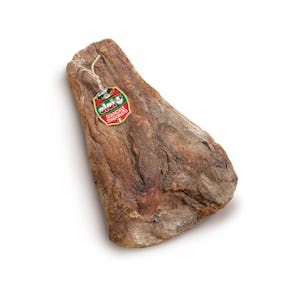- Categories
- Brands
- Origin
- Sort by: Recommended
Guanciale
Italian Cured Pig Jowl
WHAT IS GUANCIALE?
An iconic and well-loved delicacy, guanciale is a rich, fatty piece of Italian cured meat, consisting of the pork jowl or pork cheeks. Pronounced “gwahn-CHAH-leh,” it hails from Central Italy, particularly in the Lazio region. Its name comes from the Italian word “guancia,” meaning “cheek.” It’s a classic Italian meat, used in various dishes, adding incredible flavor to them.
It’s made with a simple curing method. The pork jowl (or cheek) is rubbed with salt and various spices, then cured for three weeks to two months, or until approximately 30% of its original weight is lost.
And what does it taste like? Incredible. It has a rich, buttery flavor, with a nice salty-savory-sweet balance. It also has a melt-in-your-mouth texture because of its high ratio of fat to meat, making it soft and tender. When cooked, the fat melts and adds an even richer dimension to it.
GUANCIALE VS BACON VS PANCETTA
Guanciale is often compared to two other cured meats—pancetta and bacon. They’re all cured, and they’re all very delicious. But they have differences, of course. Both pancetta and guanciale are staple Italian cured pork delicacies, and bacon actually originated in 1500BC China.
Similar to bacon and pancetta, guanciale is cured pork. They differ mainly in the cuts of pork used—guanciale uses pork jowl, while both pancetta and bacon are made with pork belly.
Their curing methods are also a bit different; guanciale is cured with salt and spices, pancetta is cured in salt and black pepper, and bacon is smoked aside from being cured.
HOW TO CUT AND EAT GUANCIALE
A particularly fatty Italian cured meat, guanciale needs to be cut properly. It’s best to first cut your guanciale into thin slices of about a half-centimeter thick, ensuring that you get both fat and meat in each strip (if you cut it up immediately into cubes, you might get cubes of only fat).
Cut the rind off; you can save these for later to flavor stocks and soups. Once the rind is off, and the guanciale is in strips, you can use them just like that or slice them even further. If you wish, slice them into smaller strips crosswise, around one centimeter thick.
You don’t have to cook guanciale. Because it’s cured meat, it can be eaten without cooking. Unless you’re pregnant. Pregnant women should only eat cooked guanciale. But otherwise, you can serve it cold, thinly sliced, with some cheese. You can sprinkle it over salads or use it in sandwiches. In the same way, guanciale can be sauteed in its own fat, and then added into sandwiches and salads, mixed with eggs, or used as pizza topping.
COOKING WITH GUANCIALE: ICONIC PASTAS
There are two Italian pasta dishes that iconically use guanciale: spaghetti alla carbonara, and amatriciana. These Italian dishes are open to using bacon and pancetta as alternative, as these are more commonly found outside of Italy than true guanciale. But, if you want that authenticity, guanciale is highly suggested.
Spaghetti alla Carbonara is a classic Italian dish usually associated with Rome and Italy’s Lazio region. But there have been contentions as to its origins. Some say the name came from “carbonaro,” meaning “coal burner,” therefore it must have been an easy and hearty meal made by Italian coal workers.
Others believe it to have been brought by the Allied Liberation of Rome in 1944, when American GIs contributed their rations of eggs and bacon to local Italian restaurants to help with the limited menu. Whatever its true origins, spaghetti alla carbonara is delicious and actually, pretty easy to make.
To make authentic spaghetti alla carbonara, simply sauté the guanciale, then toss with al dente spaghetti, pecorino cheese, and whisked egg. It’s a very simple dish, and allows the flavor of the guanciale to really shine.
Amatriciana is another Italian pasta that uses guanciale, and one that is also, similarly, relatively easy to make. It originated in the Lazio region of Italy, in a town called Amatrice. It contains simple, easy-to-find ingredients like tomatoes, cheese, and onions. Make the amatriciana sauce by combining crushed tomatoes, pecorino cheese, onions (optional), salt, and pepper in with the sauteed guanciale. Toss in some al dente bucatini, and serve!
STORING GUANCIALE
To store your guanciale, you may refrigerate it or freeze it. If unopened and unsliced, guanciale can last in the refrigerator for about six months. Once opened and sliced, it will last refrigerated for only 14 days. You can also freeze guanciale. Frozen, it will keep for about a year. Whether refrigerated or frozen, keep your guanciale in an airtight or vacuum-sealed container.
Whatever you decide to do with guanciale, you can be certain that it is going to be absolutely delicious. It’s a cured meat that you must enjoy at least once in your life, and one that, without question, will add a ton of flavor to your dish, simply by being itself.





